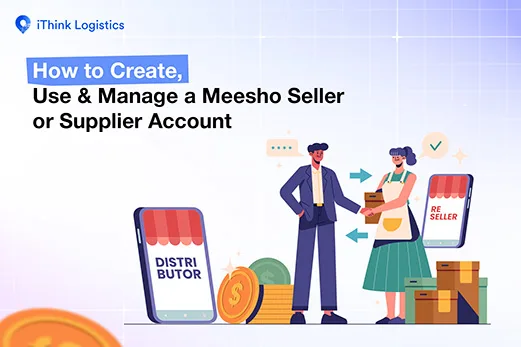The eCommerce industry has grown massively since the last decade and as the demands of online marketing seem to be overflowing with each year, the growth is unstoppable. User behavior and shopping preferences are undergoing constant changes and pretty evidently inclined more towards online shopping.
The term eCommerce fulfillment, therefore, becomes very crucial here. Right from the time a consumer-like product and purchases it online till the time it is being delivered at the doorstep, an extensive chain of processes links it all together. The seamless bandwidth of such various processes and stages includes multiple elements. These elements are crucial in the entire process of an eCommerce fulfillment.
Before understanding and knowing about the most widely used common terminologies of eCommerce fulfillment, it is essential to first brush up on what is eCommerce fulfillment.
Defining eCommerce Fulfilment
When it comes to answering the definition of eCommerce fulfillment, it can be done in very simple words. It is defined as the part of eCommerce operation which deals in delivering the purchased product to their respective customers. In an eCommerce fulfillment process, there are several activities that go on; such actions include loading the product onto fulfillment center shelves.
Here are a few of the most common terminologies of eCommerce fulfillment with their brief definitions:
Common terminologies of eCommerce fulfillment
Third-Party Logistics or 3 PL
A third-party logistics or 3 PL providers permit eCommerce business in outsourcing either part of their logistics processes or all of it. The activities that mainly include here are warehousing, distribution, along with order fulfillment services. Few third-party logistics providers also deal with specialization in transportation and warehousing services, integrated operations. These kinds of activities can be added customization which aligns as per the needs of the customers.
Fulfilment Centre
A fulfillment center is known to be a hub in which activities related to order fulfillment and inventory management of an eCommerce business are dealt with. Activities that are initiated from getting the inventory to shipping them to the end customers, all of it takes place inside a fulfillment center.
Distribution Centre
Based on the consumer’s orders, activities like receiving of the items, storing the respective inventory temporarily, and redistributing good are common facility activities of a distribution center. Warehouse and distribution centers are very closely associated terms and are mostly confused. However, there is a significant difference between a warehouse and a distribution center. A warehouse is used for storing goods or inventory for a longer period of time as compared to a distribution center which is focused more on holding the inventory for less time thereby bringing in faster turnover of goods.
Dropshipping
In very simple words, dropshipping can be defined as a process in which the order fulfillment is directly carried out by the manufacturer and not the seller. The seller will be receiving the orders from their respective customers and go ahead in forwarding them to the manufacturer for the action of fulfillment. In dropshipping, manufacturers directly produce and manufacture goods.
Inventory Management
From the management of inventory levels, seeing the sales and deliveries, inventory management has a very precise set of activities and also comprise of tracking inventory levels which makes sure that there is adequate stock at all times. Few of the most common elements of inventory management are managing raw materials, their components along with finished products. It also takes care of warehousing and looks into the processing of such items.
Self-fulfillment
When the eCommerce merchant or seller takes care of each step that comes in an internal order fulfillment process without any help of a third-party logistics provider, it is known as self-fulfillment. It is very common in the eCommerce industry especially those who are just beginning to manage inventory and packing orders in their respective place of work or residence.
Barcode
Barcode can be defined as a machine-readable form of data which represents information that helps in the identification of the products faster. The data that is stored in a barcode contains information which relates to the respective purchase order. It can identify the order and also help in accessing various other information. Such information includes customer name, carton, mode of shipping or delivery address. Documents like return documents or purchase orders contain barcodes that fetch out precise record information from the server.
SKU
SKU is an abbreviation that means Stock Keeping Unit and comprises a unique number that is associated with a specific kind of inventory for an eCommerce line of work. It is normally used for internal purposes for tracking the business inventory. SKUs are distinct alphanumeric in type and gives information relating to the essential elements of a particular product such as color, style, price, size, brand, etc.
WMS
Warehouse Management System or WMS is defined as software that is commonly used in warehouses for controlling and automating warehouse operations. From increasing the efficiency of warehousing operations to looking after various other multifunctional activities, WMS is an effective tool in the eCommerce fulfillment process. Activities like organizing, day-to-day planning, staffing, controlling, and directing how the available resources must be used for moving the inventory inside a warehouse. Warehouse Management System also helps the staff to check the performance of storage and movement in a warehouse.
SLA
SLA is known as a service legal agreement which is primarily known as a contract that is provided by a fulfillment service provider. It is an agreement that tells the owner of the business how the incoming orders are going to be handled, how the items are going to be shipped, and what will be the roles and responsibilities of the stakeholders involved in the overall management of the business.
FIFO
First-in-first-out or better known as FIFO is a type of warehousing method in which the items are received first at a warehouse shall be the first to deport the facility as well. The conceptualization of FIFO can be understood quite simply; the items which shall arrive at the warehouse first will be the ones to be held for the longest time.
This results in the items getting closer to expiry dates as the time goes on passing. Most often, business owners consider moving up the SKUs of similar items in the inventory. This is specially done so that the items can be sold off before they hit the expiry date or become perishable.
Storage Fees
The literal meaning of storage fees is similar to the phonetic meaning of the word. Storage fees can be understood as a process of charging fees to store inventory by the business owner in either the fulfillment center or in their warehouse.
Cross Docking
When the goods reach the final customer from a supplier or a manufacturing unit, this logistics process is known as cross-docking. The process usually is seen to be taking place in a terminal or a distribution docking station which has the most minimal space of storage. Receiving of the products are done at the end of such a cross-dock and known as the inbound dock. It is then transferred onto the next segment which is called the outbound dock. Furthermore, the materials received are scrutinized and sorted as per their delivery destinations.
Warehouse Kitting
Warehouse kitting can be defined as a process in which various associative SKUs are brought in to combine and create a new SKU. It involves fulfilling customer orders thereby gathering single items into consolidated kits that are good to go for shipping right away. It removes the necessity of picking and packing of individual items.
To understand warehouse kitting in a simplified way, let’s take an example. If a consumer has ordered a mobile, he or she would also order for headphones, back cover or a mobile screen guard as well. Thus, in this case, a supplier will sit and assemble all of these associative products into one single and ship to the end customer.
This brings the convenience of shopping and enhances a customer’s buying experiences.
Conclusion
Thus, these are the few of the most widely used common terminologies of eCommerce fulfillment. Each terminology mentioned here is a crucial part of the entire process and bonds it all together in a seamless stream of actions taking place each day.












